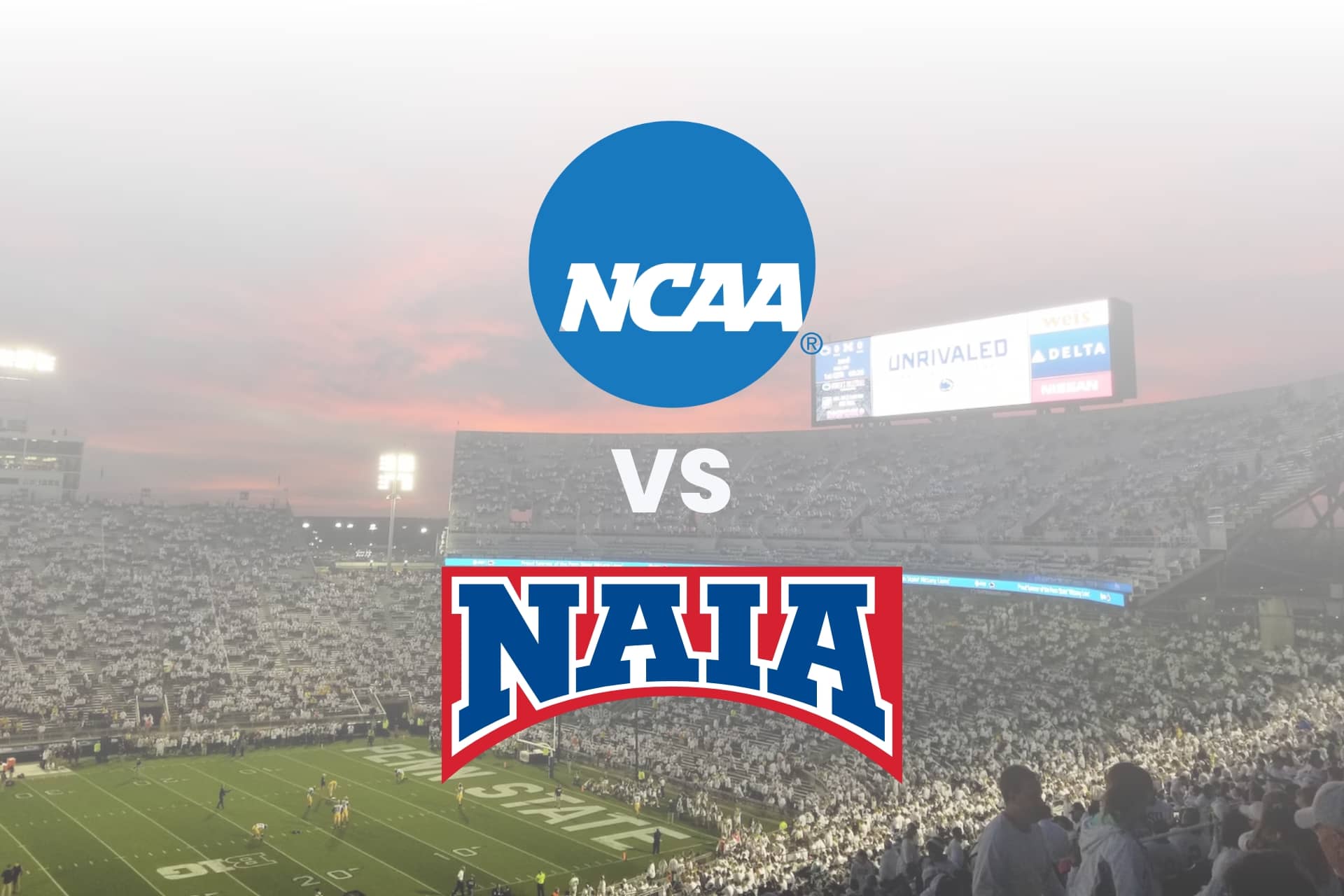What is the difference between NCAA and NAIA

When it comes to college athletics in the US, two prominent governing bodies stand out: the NCAA and the NAIA. But what is the difference between NCAA and NAIA? While both organizations oversee collegiate sports, there are distinct differences between the two that aspiring student-athletes and sports enthusiasts should be aware of.
The NCAA, or National Collegiate Athletic Association, is the larger and more well-known of the two, with over 1,100 member institutions. It is divided into three divisions, each with its own set of rules and regulations. On the other hand, the NAIA, or National Association of Intercollegiate Athletics, is a smaller organization with approximately 250 member colleges and universities.
Despite its smaller size, the NAIA offers unique advantages for student-athletes, such as a focus on character development and a more flexible eligibility process. Whether you’re a high school athlete considering your college options or simply curious about the differences between these two governing bodies, this article will provide a comprehensive overview of NCAA and NAIA, shedding light on their similarities, distinctions, and what they offer to student-athletes.
- History and background of NCAA
- History and background of NAIA
- NCAA vs NAIA: Eligibility requirements
- NCAA vs NAIA: Athletic scholarships
- NCAA vs NAIA: Academic standards
- NCAA vs NAIA: Competition level and divisions
- NCAA vs NAIA: Sports programs and opportunities
- Pros and cons of NCAA
- Pros and cons of NAIA
- Which is right for you: NCAA or NAIA?
- Conclusion
History and background of NCAA
The NCAA, or National Collegiate Athletic Association, is the larger and more well-known of the two organizations. It was founded in 1906 and currently boasts over 1,100 member institutions. The NCAA’s mission is to govern college athletics and ensure fair competition while promoting the overall well-being of student-athletes.

The NCAA is divided into three divisions: Division I, Division II, and Division III. Division I is the most competitive and offers the highest level of athletic scholarships, while Division II and Division III have varying levels of scholarship opportunities and competition.
History and background of NAIA
In contrast, the NAIA, or National Association of Intercollegiate Athletics, is a smaller organization with a rich history. It was established in 1940 and currently has approximately 250 member colleges and universities. The NAIA’s mission is to promote character-driven intercollegiate athletics and provide student-athletes with opportunities to grow both athletically and personally.

Unlike the NCAA, which is divided into divisions, the NAIA operates under a single division. This means that all member institutions compete on an equal playing field regardless of their size or resources.
NCAA vs NAIA: Eligibility requirements
One of the key differences between the NCAA and NAIA lies in their eligibility requirements for student-athletes. The NCAA has a strict set of academic and amateurism standards that student-athletes must meet in order to be eligible to compete. These standards include maintaining a minimum GPA, completing a certain number of high school courses, and passing standardized tests such as the SAT or ACT.
On the other hand, the NAIA has a more flexible eligibility process. While student-athletes still need to meet certain academic requirements, such as earning a high school diploma, the NAIA takes a more holistic approach to eligibility. This means that factors such as character, leadership, and personal growth are taken into consideration alongside academic performance.
NCAA vs NAIA: Athletic scholarships
Another important distinction between the NCAA and NAIA is the availability of athletic scholarships. The NCAA offers a wide range of athletic scholarships, particularly at the Division I level. These scholarships can cover tuition, fees, room and board, and sometimes even additional expenses such as books and supplies. However, it’s important to note that not all sports at all schools offer full scholarships, and the competition for these scholarships can be fierce.
In comparison, the NAIA also offers athletic scholarships, but the availability and amount of these scholarships can vary from institution to institution. Some NAIA schools may offer full scholarships, while others may offer only partial scholarships or no athletic scholarships at all. However, the NAIA does have a limit on the total amount of scholarship money that can be awarded to student-athletes each year, which helps ensure a more equitable distribution of funds.

Create a free profile
StudBud Athlete Profile is the best free way to find a scholarship.
NCAA vs NAIA: Academic standards
When it comes to academic standards, both the NCAA and NAIA have requirements that student-athletes must meet. The NCAA has set minimum GPA and standardized test score requirements, as well as a specific number of high school courses that must be completed. Additionally, Division I student-athletes must meet the NCAA’s sliding scale, which takes into account both GPA and test scores to determine eligibility.
Similarly, the NAIA also has academic requirements that student-athletes must meet, such as earning a high school diploma and achieving a minimum GPA. However, the NAIA takes a more individualized approach to academic eligibility, considering factors such as class rank, ACT or SAT scores, and even letters of recommendation.
NCAA vs NAIA: Competition level and divisions
One of the biggest differences between the NCAA and NAIA is the level of competition and the structure of their divisions. The NCAA is known for its highly competitive sports programs, particularly at the Division I level. Division I schools often have larger budgets, state-of-the-art facilities, and more resources to attract top-tier athletes. The competition at this level is fierce, with athletes vying for championships and national recognition.
In contrast, the NAIA offers a more balanced and inclusive approach to competition. Since all member institutions compete in a single division, there is a broader range of competition levels and opportunities for student-athletes. While some NAIA schools may have highly competitive programs, others may offer a more community-focused atmosphere where student-athletes have the opportunity to develop their skills and contribute to the team’s success.
NCAA vs NAIA: Sports programs and opportunities
Both the NCAA and NAIA offer a wide variety of sports programs and opportunities for student-athletes. The NCAA sponsors more sports than the NAIA, with over 20 different sports available for men and women at the Division I level alone. This includes popular sports such as football, basketball, and soccer, as well as less mainstream sports like rowing and lacrosse.
Similarly, the NAIA offers a range of sports programs, although the number of sports may vary from institution to institution. The NAIA is known for its commitment to offering opportunities to student-athletes in sports that may not be as widely available at the NCAA level, such as bowling, wrestling, and competitive cheer.
Pros and cons of NCAA

The NCAA offers several advantages for student-athletes. With its larger size and more prominent reputation, the NCAA provides student-athletes with the opportunity to compete at a high level and gain national exposure. Additionally, the NCAA’s Division I programs often have more resources and support services available to student-athletes, including state-of-the-art training facilities and academic support programs.
However, there are also some drawbacks to consider. The highly competitive nature of NCAA Division I sports means that student-athletes may face intense pressure to perform both athletically and academically. Additionally, the stringent eligibility requirements and the limited number of athletic scholarships can make it challenging for student-athletes to secure a spot on a team or receive financial aid.
Pros and cons of NAIA

The NAIA offers several unique advantages for student-athletes. The smaller size of the organization means that student-athletes may have more opportunities to compete and contribute to their teams. Additionally, the NAIA’s emphasis on character development and personal growth can provide student-athletes with a more well-rounded college experience.
However, there are also some limitations to consider. The availability and amount of athletic scholarships may vary from institution to institution, and some NAIA schools may not offer athletic scholarships at all. Additionally, the level of competition at the NAIA level may not be as high as at the NCAA Division I level, which may be a consideration for student-athletes seeking a more challenging athletic experience.
Which is right for you: NCAA or NAIA?
Choosing between the NCAA and NAIA ultimately depends on your personal goals, priorities, and circumstances. If you’re seeking a highly competitive athletic experience with the potential for national recognition and exposure, the NCAA may be the right choice for you. However, if you value a more holistic approach to athletics and personal growth, the NAIA may offer a better fit.
It’s important to thoroughly research and consider the opportunities, requirements, and resources available at both NCAA and NAIA schools. Additionally, consulting with coaches, current student-athletes, and college counselors can provide valuable insights and guidance in making this decision.
Conclusion
In summary, the NCAA and NAIA are two distinct governing bodies that oversee college athletics in the United States. While the NCAA is larger and more well-known, the NAIA offers unique advantages for student-athletes, such as a focus on character development and a more flexible eligibility process. Understanding the differences between these two organizations is crucial for aspiring student-athletes and sports enthusiasts alike.
By considering factors such as eligibility requirements, athletic scholarships, academic standards, competition level, and sports programs, individuals can make an informed decision about which organization aligns with their goals and aspirations. Whether you have dreams of competing at the highest level or seeking a more balanced college experience, both the NCAA and NAIA provide opportunities to pursue your passion for sports while earning a college education.
College Finder Tool
Send your video to any college coach in the country.


